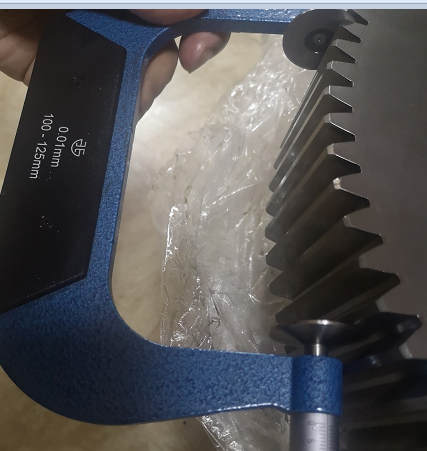The tip diameter of a gear with an odd number of teeth cannot be measured directly. This is because, in such gears, the tooth opposite any given tooth is not aligned directly across from it. In other words, odd-numbered teeth do not form an axially symmetric figure, meaning that when a tooth is rotated 180 degrees, it does not coincide with the opposite tooth.
The main reasons for measuring the gear’s base tangent length rather than the tip diameter are as follows:
1. The Significance of Measuring Base Tangent Length
Reflecting Gear Manufacturing Accuracy:
The base tangent length is an important parameter of the gear’s geometry. It directly reflects the accuracy of the gear’s tooth thickness and tooth spacing. By measuring the base tangent length, it’s possible to assess whether the gear’s manufacturing quality meets design specifications.
Facilitating Quality Control:
During the gear manufacturing process, measuring the base tangent length is a simple yet accurate method for quality control. It helps manufacturers quickly identify and correct production deviations, ensuring the overall quality of the gear products.
2. Limitations of Measuring Tip Diameter
Highly Affected by Machining Errors:
Measuring the tip diameter is highly susceptible to various machining errors, such as tool wear or machine tool inaccuracies. These errors may result in inaccurate measurements of the tip diameter, making it unreliable for truly reflecting the gear’s manufacturing precision.
Minimal Relevance to Gear Transmission Performance:
Although the tip diameter is a geometric parameter, it has little impact on the gear’s transmission performance. In contrast, the base tangent length, which reflects the accuracy of the tooth thickness and tooth spacing, has a more direct influence on the gear’s transmission performance.
3. Advantages of Measuring Base Tangent Length
Simple and Accurate Method:
The method for measuring the base tangent length is relatively simple, and the results are accurate and reliable. It is not limited by the reference surface used for measurement, and the measurement value is not affected by the tolerance of the gear’s outer diameter.
Wide Applicability:
The base tangent length measurement method is applicable to various types of gears, including spur gears and helical gears. This makes it a widely used approach in gear measurement.
4. Conclusion
In summary, measuring the gear’s base tangent length instead of the tip diameter is more effective because the base tangent length provides a more direct reflection of the gear’s manufacturing accuracy and transmission performance. The method is also simple, accurate, and widely applicable. By contrast, measuring the tip diameter is more prone to machining errors and is less relevant to gear transmission performance. Therefore, the measurement of the base tangent length has higher priority and practical value in gear measurement.
Thank you for reading. Looking forward to serving you with our exceptional gear solutions. #BeyondGears #GearManufacturing #MadeInChina
Read More:


